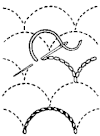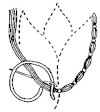Embroidery: Difference between revisions
From DT Online
(Added Template) |
(Updated Article) |
||
| Line 1: | Line 1: | ||
[[File:Embroidery | [[File:Design for Ecclesiastical Embroidery, Vertical Pattern with Tudor Rose MET DP805735.jpg|200px|right|Design for Ecclesiastical Embroidery, Vertical Pattern with Tudor Rose MET DP805735]] | ||
__TOC__ | __TOC__ | ||
=====Introduction===== | |||
===== | [https://en.wikipedia.org/wiki/Embroidery '''Embroidery'''] is the embellishment of fabrics using needle and coloured threads with a wide variety of decorative [https://en.wikipedia.org/wiki/Embroidery_stitch '''Embroidery Stitches''']. It may also include additional materials, padding and beads for example. As with so many other techniques, it has been dated back to ancient China and has changed little since. | ||
During the time of the '''The Tudors''' there was a revival in [https://en.wikipedia.org/wiki/English_embroidery '''English Embroidery''']. The high standard of work from the Anglo-Saxon period to the end of the Middle Ages had made England famous throughout the world but this had declined. Previously, the emphasis was on elaborately decorated religious vestments and furnishings for worship but following the [https://en.wikipedia.org/wiki/Reformation '''Reformation'''], the focus became clothing and household furnishings. | |||
=====Materials===== | |||
* Fabrics must be strong enough to withstand being held tight whilst embroidering and retain its shape when released. It should have a [https://en.wikipedia.org/wiki/Units_of_textile_measurement#Thread_count '''Thread Count'''] which allows the needle and thread to pass through easily. Even-weave cotton fabrics are suitable for surface embroidery and for [https://en.wikipedia.org/wiki/Cross-stitch '''Cross Stitching'''], Aida Cloth is available. | |||
* [https://en.wikipedia.org/wiki/Embroidery_thread '''Embroidery Threads'''] are available in a wide range of colours and can be combined to increase thickness. Stranded Cotton Floss can be be separated into individual threads to provide a variety of thicknesses. | |||
=====Equipment===== | |||
* [https://en.wikipedia.org/wiki/Embroidery_hoop '''Embroidery Hoops'''] are used a pull the fabric tight and provide a convenient way of holding the workpiece as embroidery proceeds. | |||
* [https://en.wikipedia.org/wiki/Sewing_needle '''Embroidery Needles'''] have sharp points and an elongated eye to enable easier threading to thicker [https://en.wikipedia.org/wiki/Embroidery_thread '''Embroidery Threads''']. [https://en.wikipedia.org/wiki/Sewing_needle '''Tapestry Needles''' have a large eye but a blunted tip to allow them to pass through the weaves of fabric without causing damage. | |||
* Water based '''Transfer Pens''' provide one way of creating a design outline on the fabric withe advantage that the marks can be washed out afterwards. | |||
* A '''Lightbox''' is a useful addition to help trace designs from paper patterns on to fabric. | |||
=====Embroidery Stitches===== | |||
{| | |||
|- | |||
| [https://en.wikipedia.org/wiki/Running_stitch '''Running Stitch'''] | |||
| The [https://en.wikipedia.org/wiki/Running_stitch '''Running Stitch'''] is the basic general sewing stitch on which all other stitches are based. It is quick to do and can be used for outlines. | |||
| [[File:Running stitch.gif|100px|right|Running Stitch|link=https://en.wikipedia.org/wiki/Running_stitch]] | |||
|- | |||
| [https://en.wikipedia.org/wiki/Backstitch '''Backstitch'''] | |||
| The [https://en.wikipedia.org/wiki/Backstitch '''Backstitch'''] is a basic sewing stitch that can be used to set the outline of a shape which might later be filled using a [https://en.wikipedia.org/wiki/Satin_stitch '''Satin Stitch'''] for example. | |||
| [[File:Backstitch.gif|100px|right|Backstitch|link=https://en.wikipedia.org/wiki/Backstitch]] | |||
|- | |||
| [https://en.wikibooks.org/wiki/Sewing/Embroidery#Back_stitches '''Split Stitch'''] | |||
| The [https://en.wikibooks.org/wiki/Sewing/Embroidery#Back_stitches '''Split Stitch'''] is created by bringing the needle up in between two previously sewn threads. It produces a good solid outline with added texture but can also be used as a filling stitch. | |||
| [[File:Split stitch.gif|100px|right|Split Stitch|link=https://en.wikibooks.org/wiki/Sewing/Embroidery#Back_stitches]] | |||
|- | |||
| [https://en.wikipedia.org/wiki/Chain_stitch '''Chain stitch'''] | |||
| [https://en.wikipedia.org/wiki/Chain_stitch '''Chain stitches'''] can be used to produce a surface embellishment and also emboldened outlines, especially useful for curved lines. | |||
| [[File:Chain stitch.jpg|100px|right|Chain stitch|link=https://en.wikipedia.org/wiki/Chain_stitch]] | |||
|- | |||
| [https://en.wikipedia.org/wiki/Embroidery_stitch#Back_stitches '''Stem Stitch'''] | |||
| A [https://en.wikipedia.org/wiki/Embroidery_stitch#Back_stitches '''Stem Stitch'''] is a type f [https://en.wikipedia.org/wiki/Backstitch '''Backstitch'''] that produces outlines resembling rope. AS the name suggests, it is commonly used for flower stems. | |||
| [[File:Stem stitch.gif|100px|right|Stem Stitch|link=https://en.wikipedia.org/wiki/Embroidery_stitch#Back_stitches]] | |||
|- | |||
| [https://en.wikipedia.org/wiki/Buttonhole_stitch '''Buttonhole Stitch'''] | |||
| The [https://en.wikipedia.org/wiki/Buttonhole_stitch '''Buttonhole Stitch'''] is a more closely packed version of a [https://en.wikipedia.org/wiki/Blanket_stitch '''Blanket Stitch'''] which can be used for surface decoration, to finish an edging or to secure addition materials in '''[[Appliqué]]''' work. | |||
| [[File:Buttonhole stitch.gif|100px|right|Buttonhole Stitch|link=https://en.wikipedia.org/wiki/Buttonhole_stitch]] | |||
|- | |||
| [https://en.wikipedia.org/wiki/Satin_stitch '''Satin Stitch'''] | |||
| The [https://en.wikipedia.org/wiki/Satin_stitch '''Satin Stitch'''] is a commonly used filler stitch for flowers and leaves. | |||
| [[File:Satin stitch.gif|100px|right|Satin Stitch|link=https://en.wikipedia.org/wiki/Satin_stitch]] | |||
|- | |||
| [https://en.wikipedia.org/wiki/Featherstitch '''Feather Stitch'''] | |||
| The [https://en.wikipedia.org/wiki/Featherstitch '''Feather Stitch'''] is a variation of a [https://en.wikipedia.org/wiki/Chain_stitch '''Chain Stitch'''] which produces a highly textured surface wider than a standard [https://en.wikipedia.org/wiki/Chain_stitch '''Chain Stitch'''] making it suitable for wide bands and rows. It is a very naturalistic looking stitch that is often used to make leaves and branches. | |||
| [[File:Feather stitch.jpg|100px|right|Feather Stitch|link=https://en.wikipedia.org/wiki/Featherstitch]] | |||
|- | |||
| [https://en.wikipedia.org/wiki/Cross-stitch '''Cross Stitch'''] | |||
| [https://en.wikipedia.org/wiki/Cross-stitch '''Cross Stitch'''] is the oldest form of embroidery in which designs are built up using crossed threads. It is featured in many examples of traditional folk art and was very popular with '''[[The Victorians]]''' when young girls were taught to sew by producing [https://en.wikipedia.org/wiki/Sampler_(needlework) '''Samplers'''] embroidered with cross-stitched alphabets, numbers, birds and other animals. | |||
| [[File:Cross stitch canvas.jpg|100px|right|Cross Stitch|link=https://en.wikipedia.org/wiki/Cross-stitch]] | |||
|- | |||
| [https://en.wikipedia.org/wiki/Knotted_stitch '''French Knot'''] | |||
| [https://en.wikipedia.org/wiki/Knotted_stitch '''French Knots'''] are used to create highly textured, '''Candlewick''' type filled areas ''(e.g. to form the centre of a flower)''. | |||
| [[File:French knot.svg|100px|right|French Knot|link=https://en.wikipedia.org/wiki/Knotted_stitch]] | |||
|- | |||
| [https://en.wikipedia.org/wiki/Couching '''Couching'''] | |||
| [https://en.wikipedia.org/wiki/Couching '''Couching'''] ''(aka Laid Work)'' involves stitching over lengths of thicker yarn or strips of material which are laid on the surface of the workpiece. | |||
| [[File:Couching.gif|100px|right|Couching|link=https://en.wikipedia.org/wiki/Couching]] | |||
|} | |||
=====Activity===== | |||
Make a small [https://en.wikipedia.org/wiki/Sampler_(needlework) '''Sampler'''] to practice a selection of [https://en.wikipedia.org/wiki/Embroidery_stitch '''Embroidery Stitches'''] and finish it with an embroidered [https://en.wikipedia.org/wiki/Monogram '''Monogram'''] based on your own initials. | |||
---- | |||
| Line 18: | Line 91: | ||
[[Category:Skills and Processes]] | [[Category:Skills and Processes]] | ||
[[Category:The Tudors]] | |||
[[Category:The Victorians]] | |||
Revision as of 15:23, 23 September 2017
Introduction
Embroidery is the embellishment of fabrics using needle and coloured threads with a wide variety of decorative Embroidery Stitches. It may also include additional materials, padding and beads for example. As with so many other techniques, it has been dated back to ancient China and has changed little since.
During the time of the The Tudors there was a revival in English Embroidery. The high standard of work from the Anglo-Saxon period to the end of the Middle Ages had made England famous throughout the world but this had declined. Previously, the emphasis was on elaborately decorated religious vestments and furnishings for worship but following the Reformation, the focus became clothing and household furnishings.
Materials
- Fabrics must be strong enough to withstand being held tight whilst embroidering and retain its shape when released. It should have a Thread Count which allows the needle and thread to pass through easily. Even-weave cotton fabrics are suitable for surface embroidery and for Cross Stitching, Aida Cloth is available.
- Embroidery Threads are available in a wide range of colours and can be combined to increase thickness. Stranded Cotton Floss can be be separated into individual threads to provide a variety of thicknesses.
Equipment
- Embroidery Hoops are used a pull the fabric tight and provide a convenient way of holding the workpiece as embroidery proceeds.
- Embroidery Needles have sharp points and an elongated eye to enable easier threading to thicker Embroidery Threads. [https://en.wikipedia.org/wiki/Sewing_needle Tapestry Needles have a large eye but a blunted tip to allow them to pass through the weaves of fabric without causing damage.
- Water based Transfer Pens provide one way of creating a design outline on the fabric withe advantage that the marks can be washed out afterwards.
- A Lightbox is a useful addition to help trace designs from paper patterns on to fabric.
Embroidery Stitches
| Running Stitch | The Running Stitch is the basic general sewing stitch on which all other stitches are based. It is quick to do and can be used for outlines. | |
| Backstitch | The Backstitch is a basic sewing stitch that can be used to set the outline of a shape which might later be filled using a Satin Stitch for example. | |
| Split Stitch | The Split Stitch is created by bringing the needle up in between two previously sewn threads. It produces a good solid outline with added texture but can also be used as a filling stitch. | |
| Chain stitch | Chain stitches can be used to produce a surface embellishment and also emboldened outlines, especially useful for curved lines. | |
| Stem Stitch | A Stem Stitch is a type f Backstitch that produces outlines resembling rope. AS the name suggests, it is commonly used for flower stems. | |
| Buttonhole Stitch | The Buttonhole Stitch is a more closely packed version of a Blanket Stitch which can be used for surface decoration, to finish an edging or to secure addition materials in Appliqué work. | |
| Satin Stitch | The Satin Stitch is a commonly used filler stitch for flowers and leaves. | |
| Feather Stitch | The Feather Stitch is a variation of a Chain Stitch which produces a highly textured surface wider than a standard Chain Stitch making it suitable for wide bands and rows. It is a very naturalistic looking stitch that is often used to make leaves and branches. | |
| Cross Stitch | Cross Stitch is the oldest form of embroidery in which designs are built up using crossed threads. It is featured in many examples of traditional folk art and was very popular with The Victorians when young girls were taught to sew by producing Samplers embroidered with cross-stitched alphabets, numbers, birds and other animals. | |
| French Knot | French Knots are used to create highly textured, Candlewick type filled areas (e.g. to form the centre of a flower). | |
| Couching | Couching (aka Laid Work) involves stitching over lengths of thicker yarn or strips of material which are laid on the surface of the workpiece. |
Activity
Make a small Sampler to practice a selection of Embroidery Stitches and finish it with an embroidered Monogram based on your own initials.
See also Decoupage, Marquetry, Inlay, Appliqué, and Collage





















